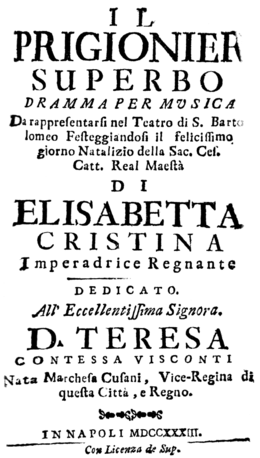Il prigionier superbo
| Il prigionier superbo | |
|---|---|
| Opera seria by G. B. Pergolesi | |
 Title page of the libretto | |
| Translation | The Proud Prisoner |
| Librettist | Gennaro Antonio Federico |
| Language | Italian |
| Based on |
La fede tradita e vendicata by Francesco Silvani |
| Premiere |
5 September 1733 Teatro San Bartolomeo, Naples |
Il prigionier superbo (The Proud Prisoner) is an opera seria in three acts composed by Giovanni Battista Pergolesi to a libretto attributed to Gennaro Antonio Federico and based on an earlier libretto by Francesco Silvani for Gasparini's opera, La fede tradita e vendicata. It was premiered at the Teatro San Bartolomeo in Naples on 5 September 1733 and received further performances in October. The opera, with its labyrinthine plot involving the rivalry of Metalce (King of the Goths) and Viridate (Prince of Denmark) for the hand of Rosmene (a Norwegian princess whose father is Metalce's prisoner), soon sank into oblivion, but its comic intermezzo, La serva padrona (also by Pergolesi) was to achieve considerable success when performed on its own.
Performance history
Il prigionier superbo was Pergolesi's second opera seria. The libretto has been attributed to Gennaro Antonio Federico and was based on the one written by Francesco Silvani for Francesco Gasparini's 1704 opera, La fede tradita e vendicata (Faith Betrayed and Vindicated). It was commissioned to celebrate Empress Elisabeth Christine's birthday and premiered at the Teatro San Bartolomeo in Naples on 5 September 1733.[1]
The performance also marked the re-opening of Naples' theatres following the violent earthquake which had struck the area on 29 November 1732. The opera continued to be performed in October of that year along with its comic intermezzo, La serva padrona. Il prigionier proved unsuccessful in its day and has only been rarely revived. However, La serva padrona performed on its own eventually went on to enjoy fame throughout Europe for many years after its premiere.[2]
The first production of Il prigionier in modern times took place at the Teatro Pergolesi in Jesi on 27 September 1997 with a score revised by Marcello Panni.[3] The next major revival came on 11 September 2009, again at the Teatro Pergolesi, this time using a new critical edition of the score prepared by Claudio Toscani for the Fondazione Pergolesi-Spontini. The production was directed by Henning Brockhaus with Corrado Rovaris conducting the Accademia Barocca de I Virtuosi Italiani performing on period instruments.[4]
Roles
| Role | Voice type[5] | Premiere cast[6] 5 September 1733 |
|---|---|---|
| Sostrate, King of Norway, Rosmene's father | tenor | Giovanni Battista Pinacci |
| Rosmene, Sostrate's daughter | contralto | Anna Bagnolesi |
| Metalce, King of the Goths | contralto (en travesti) | Lucia Grimani |
| Ericlea, Daughter of Clearco, the former King of Norway | soprano | Rosa Mancini |
| Viridate, Royal Prince of Denmark | soprano castrato | Antonio Castoro |
| Micisda, Prince of Bohemia and Ericlea's lover | soprano (en travesti) | Anna Maria Mazzoni |
Recordings
- Audio: Giovanni Battista Pergolesi: Prigionier superbo – Angelo Manzotti (Viridate), Ezio di Cesare (Sostrate), Lucia Rizzi (Rosmene); Orchestra Filarmonica Marchigiana, Marcello Panni (conductor). Live recording from the Teatro Pergolesi in Jesi, September 1997. Label: Bongionvanni.
- Video: Giovanni Battista Pergolesi: Il prigionier superbo – La serva padrona - Marina Comparato (Viridate), Antonio Lozano (Sostrate), Marian Rodriguez Cusi (Rosmene), Marina Di Liso (Metalce), Ruth Rosique (Ericlea), Giancinta Nicotra (Micisda); Accademia Barocca de I Virtuosi Italiani, Corrado Rovaris (conductor), Henning Brockaus (stage director). Live recording from the Teatro Pergolesi in Jesi, December 2010. Label: Arthaus Musik
References
Notes
- ↑ Premiere date as given in Hucke and Monson and in Sità (2007). Note that Casaglia (2005) gives the premiere date (erroneously) as 28 August 1733, the actual date of the Empress's birthday
- ↑ Grout and Williams (2003) p. 232
- ↑ Muraro and Biggi (1998) pp. 105-106.
- ↑ Fondazione Pergolesi-Spontini, 10 September 2009
- ↑ Voice types according to Sità (2007).
- ↑ Premiere cast according to the original libretto.
Sources
- Original libretto: Il Prigionier superbo. Dramma per musica da rappresentarsi nel teatro di San Bartolomeo, festeggiandosi il felicissimo giorno natalizio della sacra cesarea cattolica real maestà di Elisabetta Cristina imperadrice regnante, dedicato all’eccellentissima signora donna Teresa contessa Visconti, nata marchesa Cusani, viceregina di questa città e regno, Naples, 1733 (critical transcription at Varianti all'Opera. Accessed 5 January 2016)
- Casaglia, Gherardo, "28 Agosto 1733", Almanacco Amadeus, 2005. Accessed 27 August 2010 (in Italian).
- Fondazione Pergolesi-Spontini, "Il Prigionier Superbo di Pergolesi in un nuovo allestimento con la regia di Henning Brockhaus", 10 September 2009. Accessed 27 August 2010 (in Italian).
- Sità, Maria Grazia, "Prigionier superbo, Il". In Gelli, Piero and Poletti, Filippo (eds.), Dizionario dell'Opera 2008, Baldini Castoldi Dalai, 2007, ISBN 88-6073-184-4. Accessed online 5 January 2016 (in Italian).
- Grout, Donald Jay and Williams, Hermine Weigel, A Short History of Opera, Columbia University Press, 2003, pp. 229–232. ISBN 0-231-11958-5
- Hucke, Helmut & Monson, Dale E. "Pergolesi, Giovanni Battista". In Deane L. Root. Grove Music Online. Oxford Music Online. Oxford University Press. (subscription required)
- Muraro, Maria Teresa and Biggi, Maria Ida (eds.), Opera '98. Annuario dell'opera lirica in Italia, EDT srl, 1998, pp. 105–106. ISBN 88-7063-375-6